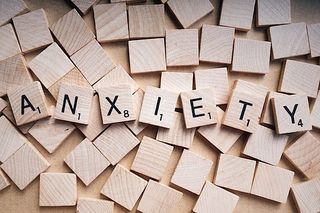
On June 11, a New York Times article, “An Anxious Nation,” chronicled how our society has seemingly become one where the diagnosis of anxiety now rivals that of depression. Poignantly the article suggests that, “Anxiety is starting to seem like a sociological condition, too: a shared cultural experience that feeds on alarmist CNN graphics and metastasizes through social media.” The article’s author, Alex Williams, provides some seriously worrisome statistics, including the fact that on college campuses anxiety disorders are now more common than depression, which has always been the leading mental health disorder among university students. Worse, the National Institute of Mental Health reports that 38 percent of teenage girls and 26 percent of teenage boys have an anxiety disorder.

The recent phenomenon of the “fidget spinner”—a device originally developed to help children with anxiety, ADHD or autism—has seen explosive sales, particularly among children, adolescents, and young adults who appear to use it to alleviate anxious feelings.
One explanation for the spike in anxiety among teens and young adults may be found in the Times Sunday Review section that same day — “Texting With Boys.” Kaitlyn Greenidge discussed how we react with anxiety and apprehension while we watch someone with whom we are texting appear to be texting back as the “typing awareness indicator” bubbles parade in front of our face. It is truly mesmerizing for many and I have watched people stare at these dots for long periods of time and seen their moods vacillate from anticipation to sadness to anger. And it is entirely possible that the person is not texting at all but just left their cursor in the text box. Frustrating beyond belief.
So who gets more anxious as a result of technology usage? In a study published in 2014, Dr. Nancy Cheever and our lab conducted an experiment to see what would happen if we deprived college students the ability to access their smartphones and induced a state of boredom where they were not allowed to do anything. Sounds stressful, right? For some it was and for others, it was not. Over an hour-plus of boredom, we measured anxiety using a simple self-report scale (the state portion of the well respected State-Trait Anxiety Inventory) three times, after about 10 minutes, after about 30 minutes and again after about an hour. Turns out that when we looked at the daily smartphone use of our 163 subjects and split them into thirds, the bottom third, those who used their phone the least, showed no change in anxiety across the boring hour. The middle third did not show any increase in the first ten minutes but did increase their anxiety at the 30-minute testing and then stayed at a constant but moderate level of anxiety for the duration. The heaviest users, our top third, showed an increase in anxiety 10 minutes into the boring situation and continued to feel increasingly anxious throughout the hour-plus period far eclipsing the moderate users even after 30 minutes. What I didn't tell you is that half of the group had their phone taken away and replaced with a claim check and the other half had to turn their phone off and place it out of sight. It really didn’t matter: Turns out that out of sight is definitely not out of mind.
Cheever is now following up the study by examining the impact of a text message interruption on physiological signs of arousal and, perhaps, stress.

You may have seen this experiment being performed on Anderson Cooper on an April 9, 2017 segment on 60 Minutes entitled "Brain Hacking." In a simulation of the study, Anderson was hooked up to a galvanic skin response (GSR) device, which monitors electrodermal activity (EDA) as well as a device monitoring his heart rate. EDA is that sweaty feeling that you feel when you are anxious or excited and your hands start to sweat a bit (happens to me during every episode of the television show 24). Anderson was instructed to read material on a screen and to leave his phone by his side. After a few minutes, Cheever told him that his phone was interfering with the electrical equipment and she needed to move it a few feet behind him. Shortly after, Cheever texted Anderson’s phone and we saw an immediate spike in his skin conductance. She did it four times and each time the GSR spiked. Finally, outside the protocol, she called his phone and got a huge reaction spike in GSR and he turned his head to try to see who was calling him. Earlier in the day when he was interviewing me, he admitted that he was not paying close attention to my answers because he had silenced his phone and put it on the floor at the foot of his chair and he was anxious about missing out on his texts and other messages. He was profoundly impressed by the strength of his anxiety reactions both in the experiment and during the interview.
Recent research has demonstrated the impact of even having a conversation with someone when a third person’s phone is placed nearby. In one study researchers placed either one of the two participants’ phones close by as they communicated or a phone that did not belong to either conversant. Following a 10-minute discussion between the two people, each person felt less close and less trusting of the other. In another study participants completed puzzles while the experimenter either called their phone (sitting on a table behind them) or did not call their phone. Those who endured a missed phone call showed increased anxiety as well as decreased performance on the puzzles compared to a group with no interruption. Another study indicated that even the “mere presence” of one’s phone led to decreased performance on all but the easiest tasks.
In our lab, we have tested models showing the impact of anxiety (as well as other variables such as executive functioning and boredom) in other domains. In a study of the impact of these variables on sleep problems among college students, we found that a particular form of anxiety that some call FOMO—“fear of missing out”—predicted more daily smartphone use, more preference for multitasking and more nighttime awakenings to check a phone which, in turn, predicted sleep problems. In another study, using a similar model to predict performance in an upper-division college general education course, FOMO directly predicted lower grades but also predicted more daily smartphone use, shorter attention span while studying and a lack of classroom digital “metacognition” (defined as knowing how to control your focus during lecture and not be distracted by technology) which, in turn, predicted poor grades.
Smartphones have been a major part of our world for a decade or so and it appears that they (and other devices, too) are having a deleterious effect on our mental and emotional functioning. People who use them a lot (and that is most of us) cannot seem to stay away from them and the research is pretty clear that one major cause is anxiety. Whether it is FOMO or some other technology-related anxiety is an open research question. Regardless, we know that some form of anxiety is driving us to check in constantly with our technology.
In the study mentioned earlier predicting course grades students installed an app on their computer called “Instant Quantified Self” which monitors smartphone use. The typical college junior/senior unlocked his/her phone 60 times a day for a total of 220 minutes. Try it yourself and see how often you check your phone. Also, pay attention to times when you “think” that your phone vibrated in your pocket or purse and find that either it didn’t or it wasn't even in that location. Normal neuronal activity, previously meriting a quick scratch to quell an itch, now is perceived as a phantom pocket vibration. That is a function of anxiety.
I get asked all the time by the media, by parents, by teachers and nearly every group I have spoken with in the past 10 years what I think long-term usage is going to do to our children. I think we are already seeing some of the ramifications. If anxiety disorders are increasing in teenagers, perhaps this is due to incessant smartphone use in general and use for communication purposes in specific. Our smartphone is a marvelous device that gives us more power than many computers and has everything we could want and need with us all day (and night) long. As companies vie for your attention you will be faced with new apps that allow you to do more and new websites that grab your attention. More of those bubbles will increase your anxiety. More social media platforms will demand your attention. The 60 Minutes segment on brain hacking tells you more about this and I encourage you to watch it as well as the auxiliary overtime material on 60 Minutes Overtime.
In the meantime, there are strategies you can use to moderate your smartphone usage and become a smarter, more focused and more productive user. You do not have to salivate like Pavlov’s dogs when your phone beeps or vibrates. You can avoid phantom vibrations. For clear strategies, take a look at the model that Adam Gazzaley and I present in our book, The Distracted Mind: Ancient Brains in a High-Tech World, in which we take a serious look at distraction from the dual perspectives of neuroscience and psychology. The final two chapters present strategies for saving your Humanware from those two perspectives.
If you have questions feel free to contact me through DrLarryRosen.com
References
Cheever, N.A., Rosen, L.D., Carrier, L.M., & Chavez, A. (2014). Out of sight is not out of mind: The impact of restricting wireless mobile device use on anxiety levels among low, moderate and high users. Computers in Human Behavior, 37, 290-297.
Rosen, L. D., Carrier, L. M., Miller, A., Rokkum, J., & Ruiz, A. (2016). Sleeping With Technology: Cognitive, Affective and Technology Usage Predictors of Sleep Problems Among College Students. Sleep Health: Journal of the National Sleep Foundation, 2, 49-56.
Rosen, L. D., Carrier, L. M., Pedroza, J. A., Elias, S., O’Brien, K. M., Lozano, J., Kim, K., Cheever, N. A., Bentley, J., & Ruiz, A. (accepted for publication). The Role of Executive Function and Technological Anxiety (FOMO) in College Course Performance as Mediated by Technology Usage and Multitasking Habits, Psicologia Educativa (The Spanish Journal of Educational Psychology).
Gazzaley, A. & Rosen, L. D. (2016). The Distracted Mind: Ancient Brains Living in a High-Tech World. MIT Press.




